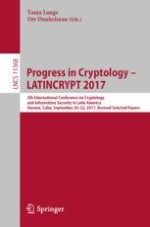2019 | OriginalPaper | Chapter
Using Level-1 Homomorphic Encryption to Improve Threshold DSA Signatures for Bitcoin Wallet Security
Authors : Dan Boneh, Rosario Gennaro, Steven Goldfeder
Published in: Progress in Cryptology – LATINCRYPT 2017
Publisher: Springer International Publishing
Activate our intelligent search to find suitable subject content or patents.
Select sections of text to find matching patents with Artificial Intelligence. powered by
Select sections of text to find additional relevant content using AI-assisted search. powered by
